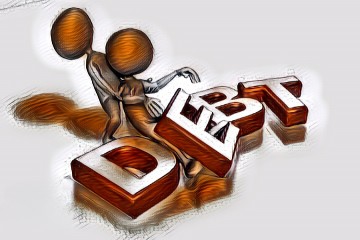Lesson 4: Debt
In this short-lesson, we will explore the fundamentals of debt, its types, the distinction between good and bad debt, and the dangers of being trapped in the debt cycle. By gaining a deeper understanding of debt, you will be equipped to make responsible financial choices and avoid the pitfalls associated with excessive borrowing.
Understanding Debt:
At its most basic level, debt refers to money borrowed from a lender with the expectation of repayment over time. When you borrow money, you enter into a contractual agreement with the lender, obligating yourself to repay the borrowed amount along with any agreed-upon interest or fees. Debt can take various forms, serving different purposes and carrying different implications.
For example, let's consider Lisa, a young adult who wanted to pursue higher education. Lisa decided to take out a student loan to pay for her tuition and living expenses. In this case, the student loan represents a type of debt that enabled Lisa to invest in her education and future earning potential.
Most Common Types of Debt:
There are several common types of debt that individuals may encounter:
-- Credit Card Debt: This type of debt arises from using credit cards to make purchases. Credit cards allow you to borrow money up to a certain limit, and if not managed responsibly, can lead to high-interest debt.
-- Student Loans: These are loans taken out to finance higher education. Student loans typically have favorable terms, but they can accumulate to substantial amounts and require responsible repayment.
-- Mortgages: A mortgage is a loan used to purchase a home. It is a long-term debt that often spans several decades and requires regular monthly payments.
-- Auto Loans: Auto loans are used to finance the purchase of a vehicle. Like mortgages, they involve regular monthly payments over a set period.
-- Personal Loans: Personal loans can be obtained for various purposes, such as home improvements, medical expenses, or debt consolidation. They typically have fixed repayment terms and interest rates.
Good Debt vs. Bad Debt:
Understanding the distinction between good and bad debt is crucial for making sound financial decisions.
-- Good Debt: Good debt is an investment in your future or assets that have the potential to appreciate in value or generate income. For example, student loans can lead to higher earning potential and career opportunities. Mortgages enable homeownership, which can build equity over time. These types of debt can contribute to long-term financial well-being and are often considered an investment in oneself.
-- Bad Debt: Bad debt refers to borrowing for unnecessary or depreciating items that do not contribute to your long-term financial goals. Accumulating high-interest credit card debt to finance extravagant purchases or using loans for non-essential expenses can quickly lead to financial difficulties. Bad debt drains your resources, accrues interest, and can become burdensome to repay.
The Debt Cycle: A Story of Financial Struggles:
To illustrate the dangers of the debt cycle, let's meet Mark. Mark is a young adult who graduated from college with student loan debt, credit card debt, and an auto loan. While trying to establish himself in the workforce, Mark found it challenging to meet his monthly debt obligations and cover his living expenses. He started relying on credit cards to make ends meet, accumulating more debt in the process. The cycle of borrowing, struggling to make payments, and accruing additional debt became overwhelming for Mark.
Breaking Free from the Debt Cycle:
Mark can break free from his debt cycle by following a few basic, yet powerful things - these things should ideally be followed by all of us to ensure that we are on the right track financially, and dont fall into a debt cycle.
-- Assess Your Financial Situation: Take a comprehensive look at your debts, including outstanding balances, interest rates, and minimum payments. This evaluation will provide a clear picture of your overall debt load.
-- Create a Realistic Budget: Establishing a budget is essential for managing your finances effectively. Identify areas where you can reduce expenses and allocate more towards debt repayment.
-- Prioritize Debt Repayment: Develop a strategy for repaying your debts. Consider the avalanche or snowball method, where you either focus on paying off debts with the highest interest rates first or start with the smallest debts to gain momentum.
-- Seek Professional Assistance if Needed: If you are overwhelmed by debt, consider reaching out to a credit counseling agency or financial advisor who can provide guidance and help you develop a personalized plan.
Debt can be a useful tool when managed responsibly, but it can also become a burden if not approached with caution. By understanding the concept of debt, distinguishing between good and bad debt, and being aware of the dangers of the debt cycle, you can make informed financial decisions and work towards achieving financial freedom.

@ayuecosystem #kids #youngadults #financialliteracy #finance #FinancialLiteracy101 #DecodingDebt #FinancialLiteracy #SmartBorrowing #DebtManagement #GoodDebtBadDebt #BreakTheDebtCycle #FinancialFreedom #DebtFreeJourney #YoungAdultFinance #ResponsibleBorrowing #DebtSolutions #FinancialEmpowerment #DebtAwareness #BudgetingForSuccess #DebtWisdom #FinancialWellness #MoneyMatters #DebtEducation #DebtStruggles #StartDebtFree